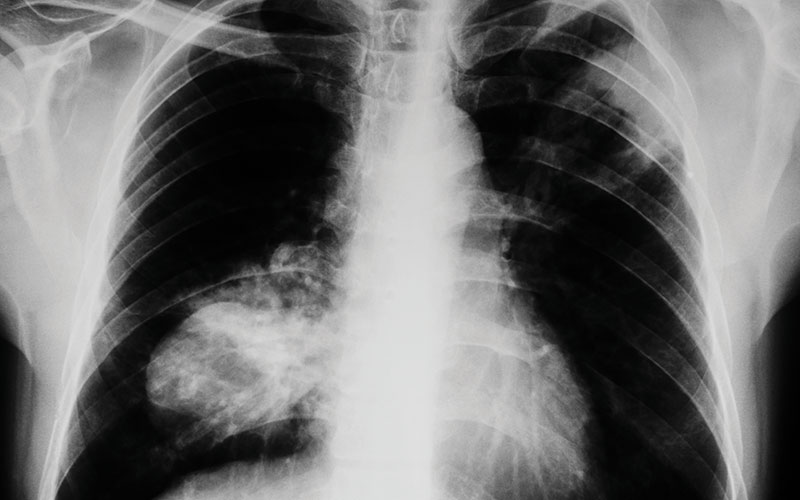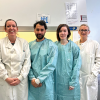Frank Sullivan, a Director of Research at the University of St Andrews, outlines a new blood test that could lead to earlier lung cancer diagnosis.

In the UK, more than 35,000 people succumb to lung cancer each year. The disease often leaves doctors powerless because, in many cases, it is diagnosed too late, when there isn’t much hope of successful treatment.
However, this might be about to change. A team co-led by Professor Frank Sullivan, the Director of Research at the University of St Andrews School of Medicine, has now shown that it is possible to diagnose lung cancer in high-risk patients before the symptoms even appear, using a blood test known as the EarlyCDT Lung test. A total of 12,209 participants were recruited as part of a clinical biomarker trial – the largest of its kind – to test this new diagnostic tool.
For the last seven years, Sullivan has been immersed in this work, so he is well aware of the devastating impact that a late diagnosis can have on patients and their families. “Lung cancer is one of the most problematic cancers in terms of getting an early diagnosis. In total, 80% of all cancers are stage III or worse by the time they are diagnosed,” Sullivan points out.
A possible reason is that the incidence of lung cancer is higher in areas that are socially and economically deprived, and this is also where people tend to seek help for symptoms at a later stage of illness and so fail to obtain help for their medical problems early enough.
The need for quicker diagnosis
Introducing a diagnostic test that is quick and easy to use, which could be offered to patients who have a high risk of developing the disease, is considered a priority in order to improve patients’ outcomes and curb mortality.
In the UK, survival from lung cancer is poor. Less than 9% of patients are still alive at five years after receiving their diagnosis. However, research has shown that those who are caught early can survive more than 10 years, with appropriate treatments.
“We used to think that there was no point in diagnosing lung cancer early, since we didn’t have the means to treat people. But great improvements have been made, and we can now treat the disease quite well with a mix of surgery, chemotherapy, radiotherapy and immunotherapy. With an early diagnosis, we can now have cure rates of 60% to 70%,” Sullivan says.
The EarlyCDT Lung test is a first step in reaching those objectives, which is why trialling it on a large scale is so important.
A new hope
In the trial led by Sullivan, more than 12,000 participants were recruited across Scotland to take part in the study in the areas of Tayside, Greater Glasgow and Clyde, and Lanarkshire. They were all aged 50 to 75 and had a high risk of developing lung cancer over the next 24 months. “These were people who were or had been smokers and/or had a family history of lung cancer. They had smoked a pack of cigarettes a day for 20 years and tended to be living in a more deprived area. However, we excluded from the trials those who had another serious disease that would have made them unsuitable for surgery,” Sullivan points out.
The test was developed as a simple ELISA blood test, looking for specific antibodies involved in the underlying biological processes of the disease. Oncimmune, who designed and developed the EarlyCDT Lung test, had approached the Scottish government in order to launch a trial, emphasising Scotland’s poor record with lung cancer mortality.
Working in collaboration with researchers at the universities in Dundee, Glasgow, Aberdeen, Nottingham and Toronto, as well as with NHS Scotland, the Scottish Government and the Canberra Hospital, Sullivan and his team randomised the participants into two groups. Their objective was to demonstrate the difference after 24 months between people who had received the blood test versus those who had received the standard NHS care – that is no intervention until symptoms appear.
Patients who took the test and had a positive result were then offered a chest X-ray followed by a CT scan. If the initial CT scan returned with a negative result, they nevertheless received subsequent CT scans every six months for the duration of the trial.
The researchers found that the test could accurately identify 32% of lung cancers which occurred during the two years in the trial. Among those who had received the EarlyCDT Lung test and went on to develop lung cancer, 41.1% were diagnosed at an early stage. This was only the case for just over a quarter of those in the control group, who received standard care.
For Sullivan and his colleagues, these results are convincing enough to warrant a larger population-based study to test the cost-effectiveness of this measure. “This was an individually randomised controlled trial, and now we want to conduct a population study with more than one round of screening. We would like to gradually include more groups to start using the test, and it will be a complex design, but eventually it may allow us to get robust evidence to start using this test routinely in the clinic and to start saving more lives,” Sullivan says.
In the long term, the goal would be to roll out the test more widely in Scotland and beyond, with the potential to revolutionise lung cancer diagnosis and treatment, and to reduce the healthcare costs associated with this devastating disease.
“We need to continue with our investigations, and carefully assess how this initiative should be offered to be entirely optimal, but this has the potential to bring huge benefits to patients. It’s a new hope for the medical community that we can be better equipped in our struggle against lung cancer,” Sullivan concludes.
Professor Frank Sullivan
- An academic general practitioner since 1984, Prof Sullivan completed his PhD in Glasgow in 1991
- Professor of Primary Care Medicine at the University of St. Andrews since 2017
- He received the British Medical Association Research Paper of the Year award in 2009 for his N Engl J Med paper on Bell’s palsy
- Member of the NCRI Lung Cancer Clinical Studies group.
Image credit | iStock




